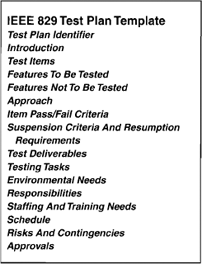2.18. Frequently Asked Questions
On projects where I use neophyte test engineers and test technicians, I find that a frequently asked questions section is useful. Many of these questions entail describing the importance of the escalation process.
2.18.1. The IEEE 829 Template: Compare and Contrast
The test plan template presented previously complies with the IEEE 829 Standard in that it contains all the same information—at least as I use the template—but presents it in a way that I consider to be inherently lighter-weight; in other words, smaller. Let me describe each field in the template briefly and how the information in my template maps to the IEEE 829 template, shown in Figure 2.7.
Figure 2.7. IEEE 829 Standard test plan template.

The Test Plan Identifier is a just a unique name or document ID. I don't explicitly include this in my template, but rather follow whatever document naming and storage conventions are used by the project.
The Introduction is used in IEEE 829 test plans the same way I use the Overview section in my template.
The Test Items, Features to Be Tested, and Features Not to Be Tested cover the issue of scope. In most of my test plans, the implicit scope is the entire system, and testing will focus on the high-risk areas of that system, which are detailed in the Scope and Quality Risks sections. As discussed previously and as I'll show in the case study ...
Get Managing the Testing Process: Practical Tools and Techniques for Managing Hardware and Software Testing now with the O’Reilly learning platform.
O’Reilly members experience books, live events, courses curated by job role, and more from O’Reilly and nearly 200 top publishers.

